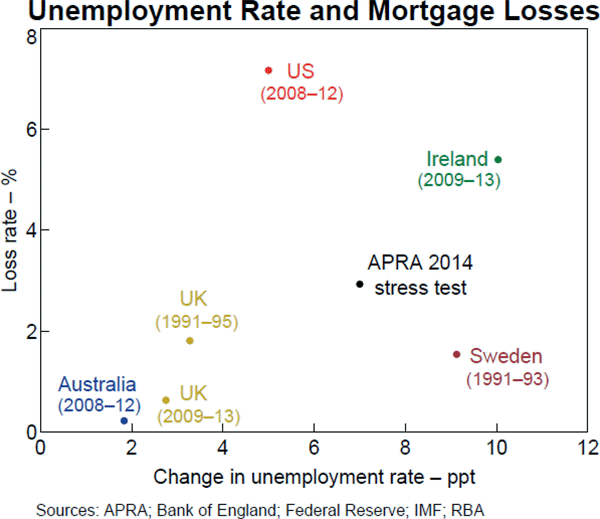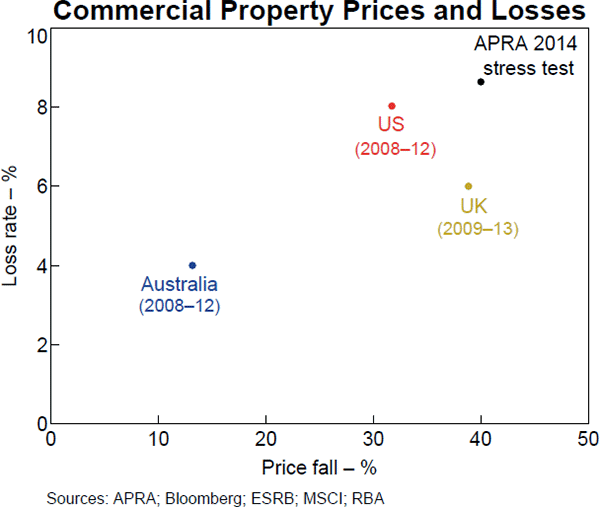Financial Stability Review – October 2017 Box D: Stress Testing at the Reserve Bank
Stress testing is a tool used to assess the health and resilience of the banking sector. It typically involves modelling the impact of an adverse macroeconomic scenario on credit losses and bank profitability in order to assess the potential effect on capital. Stress tests have become an increasingly important part of the bank regulation toolkit since the financial crisis and in some countries they are now used as an input to set macroprudential policy and capital standards.
There are two types of stress-testing frameworks, ‘bottom up’ and ‘top down’. In the bottom-up framework individual banks are required to determine the impact of a common scenario using detailed data on their assets and liabilities, internal risk models and recovery plans, in a process overseen by the regulator. These stress tests usually focus on the impact on individual institutions rather than risks to the system as a whole. In contrast, a top-down framework typically involves central banks and other public authorities using their own models to estimate the impact of a scenario on the banking system without any involvement from individual banks. Each bank is assumed to respond to a scenario in uniform, pre-defined ways, so that variation in results across banks only reflects differences in their balance sheet structure, capital and profitability. The relative simplicity of top-down models makes them less resource intensive and more flexible, allowing authorities to run any number of scenarios. However, this simplicity comes at the cost of detail. They abstract from differences in banks' risk appetite, business models and behaviour. They also produce less granular results because they do not use the detailed data about banks' balance sheet and profitability available in bottom-up modelling.
Stress Testing in Australia
In Australia, bottom-up stress testing is undertaken periodically by the Australian Prudential Regulation Authority (APRA). APRA's stress test program aims to assess the adequacy of banks' capital and assist Australian banks in improving their risk management and capital planning. Indeed, banks now regularly conduct internal stress tests as part of their risk management processes. More recently, stress-testing results were used as input in formulating APRA's benchmarks for unquestionably strong capital ratios for authorised deposit-taking institutions.
To supplement this work, the Reserve Bank is developing a top-down stress-testing framework. The top-down approach can help explain the differences in results across banks in bottom-up tests by applying the same parameters and assumptions to all banks. The model can also highlight the sensitivity of the overall system to a change in parameters. In addition, the top-down framework is more transparent to the public authorities as it can clearly identify how shocks propagate through a bank's balance sheet. This framework can be extended to capture systemic aspects of bank stress, such as flow-on effects to the financial system as a whole and amplification of economic downturns. This is consistent with the Reserve Bank's focus on risks affecting the whole banking sector, rather than bank-specific risks that are the focus of prudential regulators.
The remainder of this box outlines the current state of the Reserve Bank's model. As further development continues, the model will be used to explore the resilience of the Australian banking system with insights presented periodically in future Reviews and other Reserve Bank communications.
Features of the Reserve Bank's Framework
The Reserve Bank's top-down framework maps the impact of an adverse macroeconomic scenario through the major banks' balance sheets. Using assumptions about their credit losses, funding costs and non-interest income in such a scenario, the stress test generates a projection of the banks' profits, dividends, loan growth and capital positions. As is standard with top-down stress testing in other countries, many actions to mitigate the impact – such as capital raising and loan repricing – are typically not incorporated into the primary stress tests in order to isolate the impact from the potential response and also because the efficacy of these actions is uncertain in times of stress. However, the effect of mitigating actions can be explored in subsequent stress-test specifications.
The Reserve Bank model primarily relies on behavioural rules and accounting identities to generate projections of bank profitability and capital from a scenario (Table D1). In particular, behavioural rules are used to determine the pace of asset growth and dividend payments: as capital ratios fall below normal levels, banks choose to reduce their dividend payout ratios and constrain lending growth, while investors demand higher returns when providing funding to banks. In addition, there are some variables that are pre-specified outside the model, notably credit losses, the evolution of risk weights and funding costs.
| Pre-specified outside of the model | Accounting identity | Behavioural rule |
|---|---|---|
| Credit losses | Net interest income | Asset growth |
| Risk weights | Capital | Dividends |
| Funding costs | Profits | Additional funding costs |
| Lending rates | ||
| Non-interest income |
Credit losses are determined by benchmarking from historical episodes and past stress tests in Australia and abroad, and from Australian banks' Pillar 3 disclosure requirements. Graph D1 and Graph D2 show relationships that could be used to estimate the loss rate on mortgages and commercial property lending. These illustrate the highly uncertain, and possibly non-linear, relationships between economic variables and loss rates that need to be incorporated in a scenario.


An alternative approach used by many central banks is to use statistical techniques to model credit losses based on historical relationships between observable default rates and economic variables (such as the unemployment rate and asset prices). This approach has not been used for Australia because large credit loss events have been rare and existing models have limited explanatory power. The only sizeable credit loss event in modern Australian history was during the 1990s recession and there are limited granular data from this period. In addition, structural changes to banks' balance sheets and lending standards since that time make it hard to draw implications from that event for current times. These challenges are illustrated by research models such as Rodgers (2015), Bilston, Johnson and Read (2015) and Kenny, La Cava and Rodgers (2016), which produce either very low credit losses when subject to quite severe stress scenarios or do not find a robust link between losses and the business cycle.[1]
Risk weights are an important determinant of a bank's capital ratio and tend to rise during stress as they take into account changes in economic conditions. The magnitude of changes is, however, difficult to predict and can vary substantially across banks. The Reserve Bank model therefore calibrates the evolution of risk weights using the results of previous bottom-up stress tests conducted by APRA.
Changes in banks' funding costs are also pre-specified, given that shocks to markets are not easy to model. The interest rates at which banks can access deposit and wholesale funding are calibrated based on historical episodes. Banks are then assumed to experience additional increases in wholesale funding costs as capital ratios fall in the scenario. The model assumes banks absorb any increase in funding costs to abstract from the potential feedback effects of higher lending rates on household stress and hence loss rates, which cannot be determined without a credit loss model.
Sensitivity to Changes in Key Variables
The simplicity and flexibility of a top-down framework means a number of different scenarios can be considered quickly. For example, the framework can assess the sensitivity of the results and extent of non-linearities to adjustments to key variables or alternative assumptions.
This flexibility is demonstrated in this box by a simulation that shows the sensitivity of banks' CET1 capital ratios to changes in the severity of the stress event. It takes a similar stress event to APRA's 2014 bottom-up stress test, and then assumes credit losses, the fall in revenue or the rise in risk weights is either 50 per cent larger or smaller.[2]
This exercise generates a few key observations.
- First, credit losses and income shocks have non-linear effects on banks' capital ratios: the deviation in banks' capital ratios from the baseline is larger when the degree of stress is increased than when it is decreased (Table D2). This non-linearity is mostly attributable to the behavioural rule governing dividend payments. As profits decline in a stress scenario, lower dividend payouts help to cushion the impact on capital. But that ceases when profits fall to zero and losses directly reduce capital.
- Second, as the degree of economic stress evolves, the CET1 capital ratio is most sensitive to the consequent changes in risk weights. It is about twice that from changes in credit losses in the scenario (Table D2).
- Finally, credit losses have little impact on capital in these scenarios because the banks currently enter the stress period with very large pre-impairment profits. This enables them to continue generating capital through retained earnings in even quite severe episodes. However, the impact of credit losses on CET1 capital becomes larger when accompanied by greater declines in revenue.
| Less severe(a) | More severe(a) | |
|---|---|---|
| Credit losses | 15 | −30 |
| Bank revenue | 10 | −15 |
| Risk weights | 60 | −60 |
|
(a) The more (less) severe scenario assumes that either credit losses or the change in income or risk weights is 50 per cent larger (smaller) than in the baseline. Only one variable is changed at a time Source: RBA |
||
An alternative way to understand the sensitivity of capital ratios to various shocks is to run reverse stress tests. These tests estimate the magnitude and duration of stress that would result in banks breaching various thresholds. This can be used, for example, to assess how much more severe a past event or scenario would need to be in order to breach certain prudential capital requirements.
Footnotes
See Rodgers D (2015), ‘Credit Losses at Australian Banks: 1980–2013’, RBA Research Discussion Paper No 2015-06; Bilston J, R Johnson and M Read (2015), ‘Stress Testing the Australian Household Sector Using the HILDA Survey’, RBA Research Discussion Paper No 2015-01; and Kenney R, G La Cava and D Rodgers (2016), ‘Why Do Companies Fail?’, RBA Research Discussion Paper No 2016-09. [1]
In the 2014 scenario, real GDP falls by as much as 4 per cent per annum, the unemployment rate rises to 13 per cent and house prices fall by around 40 per cent. For more information, see Byres W (2014), ‘Seeking Strength in Adversity: Lessons from APRA's 2014 Stress Test on Australia's Largest Banks’, AB+F Randstad Leaders Lecture Series, 7 November. [2]